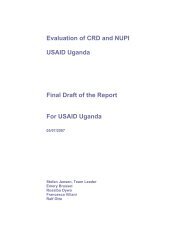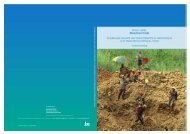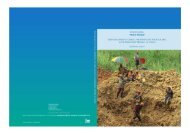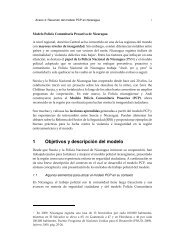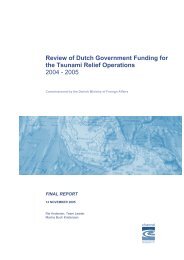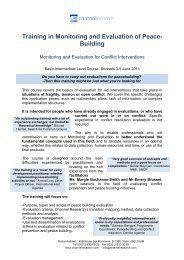A ripple in development? - Channel Research
A ripple in development? - Channel Research
A ripple in development? - Channel Research
Create successful ePaper yourself
Turn your PDF publications into a flip-book with our unique Google optimized e-Paper software.
often take place <strong>in</strong> parallel and the l<strong>in</strong>kage can be rather complicated<br />
seen from either the <strong>in</strong>tended beneficiaries’ po<strong>in</strong>t of view or from the<br />
perspective of the planner or the implementation agency. The understand<strong>in</strong>g<br />
and explicit or implicit use of the LRRD concept may thus<br />
become an important factor for the long-term impact of humanitarian<br />
relief <strong>in</strong>terventions.<br />
Because of its complexity a straightforward and simple def<strong>in</strong>ition<br />
of LRRD is not possible. The general idea is that there are l<strong>in</strong>kages –<br />
positive or negative <strong>in</strong> their consequences as well as logical or accidental<br />
– between various stages of <strong>in</strong>terventions after a disaster and these l<strong>in</strong>kages<br />
need to be explored, both <strong>in</strong> order to expla<strong>in</strong> what has happened<br />
and to learn how to do better next time.<br />
2 Purpose and objective of the evaluation<br />
The ma<strong>in</strong> purpose the evaluation is to contribute to learn<strong>in</strong>g from a<br />
large scale and complicated disaster, particularly about modes of plann<strong>in</strong>g<br />
and operation by different actors. It is desirable to have conclusions<br />
and lessons learned from the tsunami disaster that may be applied to<br />
similar situations <strong>in</strong> the future.<br />
The possibility of report<strong>in</strong>g on the results of <strong>in</strong>terventions – the<br />
accountability aspect – is also important <strong>in</strong> view of the magnitude of<br />
the disaster and the massive response it created.<br />
The first part of the LRRD evaluation served two purposes. One<br />
was to provide <strong>in</strong>formation on the LRRD theme for the ‘one year after’<br />
synthesis report published <strong>in</strong> 2006. The other was to collect basic <strong>in</strong>formation<br />
and to establish po<strong>in</strong>ts of reference, particularly regard<strong>in</strong>g the<br />
<strong>in</strong>tended beneficiaries’ views, to be used <strong>in</strong> the second LRRD evaluation<br />
phase. The LRRD evaluation complemented the other themes <strong>in</strong><br />
the TEC evaluation <strong>in</strong> order to present a comprehensive assessment of<br />
essential elements of the response to the disaster.<br />
The tsunami disaster was the last large natural catastrophe with a<br />
major <strong>in</strong>ternational response before the so-called cluster approach was<br />
applied. As such it may serve as a basis for comparison to later <strong>in</strong>ternational<br />
<strong>in</strong>terventions and this should be kept <strong>in</strong> m<strong>in</strong>d <strong>in</strong> the analysis.<br />
The objective of the follow-up evaluation is to identify l<strong>in</strong>kages,<br />
both positive and negative, between relief, recovery and <strong>development</strong><br />
activities, <strong>in</strong>vestigate results and consequences of these that have taken<br />
place dur<strong>in</strong>g the more than three years after the disaster and formulate<br />
lessons to be learned and recommendations from this. The analysis shall<br />
be carried out along the dimensions <strong>in</strong>dicated below and <strong>in</strong> section 2.2.<br />
For learn<strong>in</strong>g purposes it may be useful to make comparisons between<br />
the three countries <strong>in</strong> the evaluation. It is important to look for <strong>in</strong>tended<br />
and un<strong>in</strong>tended as well as positive or negative consequences of the<br />
<strong>in</strong>terventions and the ways they were implemented.<br />
126




